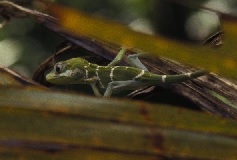Knight Anole (Anolis equestris)
Description: Adult knight anoles are about 13–20 inches in total length, including their tail that is longer than the head-and-body, and weigh 0.56–4.83 oz. Males grow larger than females, with adults of the former having a snout–vent length of 3.9–7.5 inches and the latter 3.5–6.3 inches. It is mostly bright green with a yellow stripe on the side of the head and another on the shoulder, but it is able to perform some color changes. It has a pinkish-white dewlap. Juveniles have light bands on the body.
Habitat: In Cuba they can be seen from near sea level to an altitude of 3,300 feet in a wide range of habitats with trees, such as forest, mangrove, savanna, cultivated areas and gardens. In its introduced Florida range it even occurs in trees along roads in Miami. Knight anoles are arboreal, mostly found high in trees on the trunk or branches in the canopy, but will descend to the ground to get from one tree to another, or for thermoregulation, when occasionally seen on warm asphalt, rocks, or sidewalks.
Range: Knight anoles are native to Cuba, but have been widely introduced into South Florida, where they reproduce and spread readily as an invasive species. They cannot withstand cold temperatures; in winter freezes in Florida, they have been known to fall to the ground from tree canopies. In highland parts of its native Cuba, a few individuals may rest adjacent to each other during the relatively cold winters (otherwise the species is solitary and highly territorial).
Found in these States:
FL
Diet: When young, its diet consists mainly of insects. As an adult, it mostly eats invertebrates (notably insects and snails), but regularly take fruits and can function as a seed disperser. They may also take small vertebrates prey such as small birds and reptiles (including other anoles), but studies indicate that they do this less frequently than several other anole species.
Reproduction: Breeding occurs during the summer. Courting is similar to the beginning of fighting but attitudes are less extreme. The male nods his head one or more times and frequently expands his throatfan and then seizes the female by the nape of the neck. The male forces his tail under the female to bring their cloacas in contact. The male inserts his hemipenis into the cloaca of the female. Lab studies have shown males attempting to mate with other males; possibly due to their inability to distinguish males from females.
Status: Listed as Least Concern because of its large extent of occurrence, it occurs in several protected areas, and is subject to only localized threats.
Subspecies: None in our region.
»» Kingdom: Animalia - Animals
»» Phylum: Chordata - Chordates
»» Subphylum: Vertebrata - Vertebrates
»» Class: Reptilia - Reptiles
»» Order: Squamata - Lizards
»» Family: Dactyloidae - Anole Lizards
»» Genus: Anolis
»» Species: Anolis equestris - Knight Anole
»» Subspecies: None
This article uses material from the Wikipedia article "Knight Anole", which is released under the Creative Commons Attribution-Share-Alike License 3.0. Content may have been omitted from the original, but no content has been changed or extended.
|








